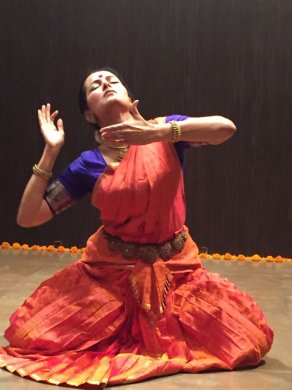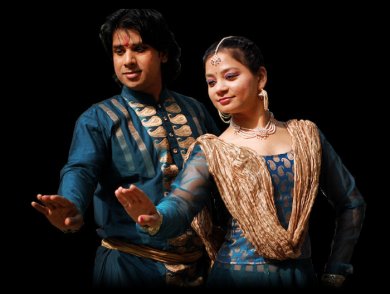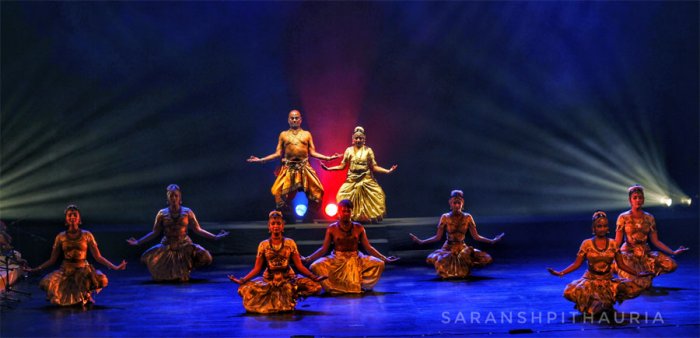
|   |

|   |
 e-mail: leelakaverivenkat@gmail.com Delhi diary November 24, 2017 Double billing of music and dance in Bharatiya Vidya Bhavan's Sangeet Samaroh The dance component of Bharatiya Vidya Bhavan's 9th consecutive Sangeet Samaroh (Nov 6 - 8, 2017) predictably sponsored traditional fare. Bharatanatyam by Priyadarsini Govind had the blend of extreme lavanyam and sensitive abhinaya which, over the years, one has come to expect as the hallmark of this dancer. Starting with a Gambheera Nattai opening attached with a homage to Muruga in Shanmukhapriya, the dancer went on to the centrepiece of the varnam in Ragamalika set to rupaka talam, the composition a vintage piece from the time honoured repertoire. "Sami nine kori naanu raa," the nayika declares her overwhelming love (prema meera) for the Tanjaipuri vaasa. But after the statements set to Todi, Shankarabharanam, Athana, in the Kalyani part, there is a sudden change of tone and mood as the besotted devotee drowned in love, becomes the confident swadheenapatika and addresses the Lord that he will not find another like her. Persuasive in her subtle mood changes, the yearning of the nayika who looks longingly at the divinity on top of the hill, looking from where she is, so unapproachable changing to the feelings of a woman so sure of her love in the latter half was well brought out. The nritta links, even while Priya's rhythmic exuberance has a quieter expression now, retains the correctness in movement profiling. Among the purely interpretative offers, the first in raga Jogia, brought out the hurt feelings of Gautama's young wife Yashodhara, who wonders how even as her body lay asleep on top of Siddharta's chest, her husband had crept away stealthily at dead of night without as much as waking her or taking leave of her. The dancer's abhinaya had vocalist Preeti Mahesh singing with great feeling. The other Dharmapuri Subbarayar composition in Kapi, "Parulanna maata namma vaddu" wherein the nayika counsels the nayaka not to be poisoned by the false words of the other woman, is a much rendered lyric one has seen Priya perform quite often on earlier occasions. The finesse in elaborating a statement - like showing fleetingly a cobra striking and slinking away in a second, and other ways in which a person's mind could be poisoned by falsehood was a test to the kind of abhinaya training Priya had under the expertise of Kalanidhi Narayanan. The Abhang in Brindavani Saranga provided a conclusion on the right note. Nattuvangam by Nityakalyani Varadarajan, mridangam by Shaktivel Muruganandan and Sikhamani on the violin comprised the rest of the fine musical support. The unfortunate part was that with poor visibility and smog, there was hardly any audience, particularly towards the end of the concert. Wiser decision would have been to have had Bharatanatyam first with the music concert forming the latter half of the evening for in Delhi for Hindustani music, the prospect of diehards staying on would be greater. Gauri Diwakar's Kathak recital, the other programme of the festival, began with an invocation to Shiva through the Panchakshara Stotram. The nritta component in Lakshmi tala of 18 matras was done with appreciable finesse and with her guru Jaikishen Maharaj conducting the concert, each finish on the sama was marked with precision with Yogesh Gangani and Mahavir Gangani on tabla and pakhawaj respectively, though the singer was not in form. The tihai in this was particularly good. The Thumri composed by Jaikishen Maharaj in dadra, roopak, keherwa which made a total of 21 matras, needed more elaboration than the instant entrance and exit that Gauri gave it. The dancer never seemed to go into the deeper meaning of the words, and generally this was a disappointment. And entering after she had taken over fifteen minutes changing her costume, which in a short programme of this nature was hardly needed, she forgot that these abhinaya pieces like pickling, need to marinate for some time in the mind for ideas to come out and for familiarising oneself with the words and the sub- text one can derive from the sahitya. And after this the Vadya Paran, a peek into Sitara Devi inspired Kathak, Tihai based on Tarana bols, Seedi gat, Parmelu - all of which though not new were cleanly executed and in an oft rendered tala which is familiar terrain. Recitals of the usual mould  Vidhya Subramanian At Sandhya Raman's cosy studio, the performance space created by clearing some areas has an intimacy, which makes it ideal for abhinaya items. And Vidhya Subramanian from the States in a short programme of abhinaya sought to bring out the intertwined relationship of sringar and bhakti, which in the many in-between layers of bhav in a composition pass through states-of-being in which the either/or or neither/nor are difficult to pin down. And love itself does not always have an erotic underpinning - for it can be motherly love or affection for a friend. Starting with an invocation to Saraswati, the Vidyadayini, Vidhya presented the famous "Jagadodharana" in Kapi wherein love takes on several colours of devotion and awe for the great Creator of the Universe, Krishna, and the vatsalya (motherly love) of Yashoda for her foster child Krishna. Here operating at two levels of the macro and the micro, one sees the divine principle reflected in its grandeur and strength placed alongside its manifestation as the prankish child adored by the mother. Krishna can be the Lord of the Universe but for Yashoda, he is the darling son she feeds, fondles, chastises for wrong doings. Power on the one side is contrasted with the childish qualities on the other. This is an endearing composition emphasising contrasts and two levels where the same divinity rouses devotion and motherly love. The erotic segments were based on the Kamas "Era raa raa" which shows the abhisarika calling out to her beloved boldly, unable to bear the pangs of desire. Rendered as if the nayika is addressing two persons, her beloved with love and Manmatha, whose flowered darts have made life very difficult, the urgency of love was well communicated. On the other hand, in "Kuru Yadunandana" the ashtapadi from the Geeta Govinda, which was done with that mix of bhakti and sensuality, it is a situation when after a night of ardour, Radha basking in the glow of complete oneness with Krishna, in after-love intimacy wishes that he repair her rumpled state by doing up her hair and tying the girdle round her waist - so that the Radha who sought his love begins the search and lila for the ultimate again. Using just the metre of the poetic word, what the dancer did on Nataraja was effective - though the Durga conclusion in the same raga, for this critic was low key. There were some queries from the small audience which however filled that little space, about how in a country like the States, these sringar padams and javalis are received. Some years ago, even the Indian community settled there felt uneasy about their children being taught sringar items. But as Vidhya said, times are changing and young people of today are far more outgoing and less bound by puritanical ideas. Bridging the Lucknow/Jaipur Gharana gap in Kathak  Amit Khinchi and Shubhi Johari Naval Kathak Utsav (Nov 15 and 16) by Samantaa Dance Company led by Amit Khinchi and Shubhi Johari, was a two day festival, which had its curtain raiser in a workshop conducted by Kumudini Lakhia. Held at Meghdoot theatre of SNA, the first day of the workshop concerned traditional compositions, while the second was an integration of contemporary aspects in traditional Kathak. Substantiating the morning sessions were evening performances at the Triveni Kala Sangam, and LTG auditorium in both the Jaipur and the Lucknow gharanas. The duet by Radhika Sathe, originally trained under Madhumita, and Eshani Sathe Akola who is now under Guru Rajendra Gangani's guidance, began with Shiv Vandana, the two dancers standing tangentially and dancing to reflect Shiva's effervescent energy in his Nirvana roopam and Brahma swaroopam. But one wishes the two performers had shown more of an interaction between them sharing stage space, instead of a feeling of two solo unconnected dancers performing together, which does not make for a duet which should have its own logic. Radhika thereafter, essaying into a pure nritta sequence with recorded music, made no sense for in Kathak with its open-endedness and improvisatory interventions, the structured feel of the dance with recorded music wherein the dancer is chained to a pre-set pattern, destroys its intrinsic character. The least is live tabla. "Nachat Sugandha Sri Nagananda," the item revelling in the butter stealing, Govardhan lifting , vanquishing Kaliya episodes - all epic deeds of young Krishna also lacked the feel of two dancers revelling in a narrative involving both. More like marionettes, each dancing her bit without interacting with the other when both are on the stage, begins to resemble a classroom, and the performance idea takes a back seat. Individually, they were correct dancers, and young Eshani is a bright dancer though the duet needed to be far better planned. The best dances were by far by the three Kalashram dancers Kanchan, Gauri and Nandini, disciples of Pt Birju Maharaj and Saswati Sen. Trikon was a real search for something out of total abstraction and it was rendered with great flair and involvement with one another and one was aware right through of all three dancers being in a joint enterprise and each reacting to the others - and suddenly spun out of the odd footsteps, rhythm, hand claps was something of an integrated nature in the dance. Music on tape was good and the three dancers seemed to have great fun out of abstract dance which at the same time said something to them. Finally, one gets the meaning of the words shareer, buddhi, aatma, nand ananda bajraho and nritya becomes not just art but Paramaananda. Here, one enjoyed a real performance and costumes too were aesthetic and not overdone. The Kathak Kendra Repertory, under Guru Rajendra Gangani, provided the concluding touches with a Tarana followed by nritta in Panchamsawari (15 matras) with one proficient male dancer Viswajit in the middle, flanked by two female dancers. This was later followed by 7 1/2 matras, which is half of the earlier 15 matras. This first part was preferable to the second half, which was the Tarana in Kalawati by a larger group, with three girls and three boys in costume colours which did not match. The choreography too, revelling in speed and footwork' kamaal' was terribly jumbled, with the costumes sporting unmatched and loud colour combinations. Somehow, when Kathak becomes devoted to a parade of skill rather than aesthetics with the right holding of the body, one wonders if the artists concerned have understood the nature of artistry, which does not always need over ornamentation of skills. The next evening at the Little Theatre Group auditorium, the organisers Amit Khinchi and Shubhi Johari took the floor. The evening entitled 'Samantaa' was a duet comprising a male Jaipur and a female Lucknow gharana dancer. The two have won laurels performing together. Their start with Shiva Shakti where male/female polarities complement each other and where one derives strength and identity from the other became also a metaphor for the different energies of the Lucknow and the Jaipur gharanas representing the entirety of Kathak. In a way, the grace of Shubhi and the manly movements of Amit made a fine contrast. Shubhi, a disciple of Jaikishen Maharaj moves with nimble ease, while Amit's Kathak reflects, to a large degree some of the grunt of effort. Their costuming was tasteful and both have an idea of programming which combines a feel for aesthetics. One liked the way the compering was woven into the performance with each exiting dancer giving particulars of the next item. And there was a feel for poetry instead of just making bald statements. Nayak, Amit's solo, with qualities of a hero mentioned as 'endurance, gallant spirit, unshakeable resolve despite setbacks, full of stamina, like a rock, with the fire (and brightness) of the Sun, strength, the Yang' were all supposed to be contained in, and expressed through, the abstract intra-forms of Dhamar Taal. The challenging rhythmic bandishes like taking chakkars balanced on one leg, and Paran Amad and Paran, which were exceedingly demanding - like taking a fully seated stance in the middle of spinning a chakkar - were all performed, the last with a degree of awkwardness, as one can understand. Shubhi's solo segment took the form of Abhisarika who sets off in search of that perfect union (sam ko pana) with the ultimate, braving all nature's discomfort of thunder, rain etc. The item was ruined by very loud and poor singing, and besura flute which took away all the delicacy of the nayika's search. The percussion too was overloud. The last part when the two halves come together saw both dancers but in a virtuosity blaze, which could have been more crisp and less prolonged. But both dancers showed some interesting facets of presentation. Natya-Rasanubhuti to herald next generation in Kuchipudi  Photo: Saransh Pithauria It was an event, marking the coming of age of the branch of the Reddys' Natya Tarangini in Hyderabad headed by daughter Yamini Reddy. The crowded Kamani auditorium (Nov 12) was proof of the large number of fans the Reddys command in Delhi. The group presentation on the lines of a dance drama was built round the nine dramatic states-of-being or rasas evoked through dance - Natya Rasanubhuti. After homage to Bharatavarsha came the Gayatri hymn Om bhur bhuvah svah invoking the lord of the three worlds, earth, and atmosphere and svah referring to whatever there is beyond the scope of our perception. The reference to the Sun suggests brightness without darkness and here the prayer is for an uncluttered mind and it is this type of intellect in Bharatavarsha which has conceived of the rasa theory in the world of aesthetics, presided over by the Guru who blesses the disciples. The production in the very deliberate chants of Raja Reddy and the enunciation of the well known Abhinaya Darpana verse "Yatho hasta, tatho drishtir, yato drishtistato manah / Yato manastato bhavo, yato bhavastato rasah" theorises on the connection of hand gesture to the eyes followed by the mind and then feeling of the inner dancer, finally evoking 'rasa,' the dramatic sentiment. The step by step theory followed by the episodic treatment of sentiments one after the other being evoked, resembled a presentation which could well have been a demonstration - with dramatic flavour thrown in. At times, it seemed like an initiation class for informing new comers. After segments in ragas Vasanti and Revati with a whole group of young disciples of the Hyderabad branch of Natya Tarangini performing in simple but correct movements, the rasa sequences followed. The music was well rehearsed with Lavanya Sundaram and D.V. Ravikant providing vocal support and with Raghavendra on violin, Anantakrishnan on flute, Kamal Ahmed on sarangi, Satish on edakka and Bhaskar Rao on mridangam forming the entire team. The best scene by far was by Bhavana Reddy who in the Hasyam sequence, with just recitation of rhythmic syllables, created a sense of mirth all the time interacting with the audience. Here is a natural funster, with a tremendous sense of timing who occupies stage space with complete confidence. The way she pranced around imitating a monkey brought the house down in laughter. Karunyam, the state of pathos, well concluded by Yamini Reddy, looking at the ravages of death and the sorrowing caused, could have been built up with more sophistication in the earlier part than the dancers clad in dramatic black and gold, suddenly aping death by falling down. The music in Shubhapantuvarali though provided the ideal backdrop. To the takatakita khandam rhythm with a jati briskly rendered, young dancers to the music in Athana showed the martial tread and fearlessness of the chivalrous warrior. Fear (bhayam) strung to a raga like Rasikapriya, again with Bhavana as the dancer, helped convey the uneasiness with strange happenings that goes with the sentiment. Bhibhatsam (disgust) was evoked by the scene of Bhima pulling out the entrails of Duryodhana. Raudra (anger) brought the mother/daughter pair of Rashmi Vaidyalingam who seems out of practice and a suddenly less slim Shloka who must watch her weight. Exquisitely attired, the two disciples Ananya Khosla and Pernia Qureshi from Yamini's classes, who presented the sringar sequence (one the nayak and the other the nayika) to the accompaniment of raga Kamas, made a convincingly romantic twosome. Raja and Radha Reddy rung in Shantam, the final state of peace. This work was a good way of informing those who needed to know how the process of 'rasa' worked in Indian dance.  Writing on the dance scene for the last forty years, Leela Venkataraman's incisive comments on performances of all dance forms, participation in dance discussions both in India and abroad, and as a regular contributor to Hindu Friday Review, journals like Sruti and Nartanam, makes her voice respected for its balanced critiquing. She is the author of several books like Indian Classical dance: Tradition in Transition, Classical Dance in India and Indian Classical dance: The Renaissance and Beyond. Post your comments Please provide your name and email id when you use the Anonymous profile in the blog to post a comment. All appropriate comments posted with name & email id in the blog will also be featured in the site. |